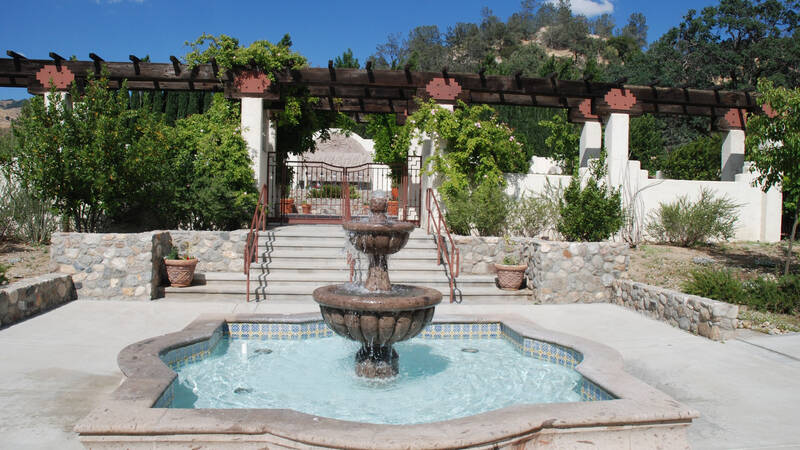Thanks to the advocacy of César E. Chávez, millions of farmworkers today have safer working conditions and union rights. The first national monument dedicated to a contemporary Latino American bears his name.
The César E. Chávez National Monument, established in 2012 just outside Keene, California, honors one of the most important labor and human rights leaders in the United States during the 20th century. It also is the first national monument associated with modern Latino history.
The son of Mexican immigrants and a former farmworker himself, César Chávez founded the National Farm Workers Association in 1962, now the United Farm Workers of America. He led a non-violent social movement to improve wages and working and living conditions for farmworkers. At the time, commercial growers subjected employees to low pay, unsafe and unsanitary conditions, pesticide exposure and child labor. They also denied employees any opportunity to form labor unions that could negotiate on members’ behalf.
Chávez laid his hope for farmworkers — many of them people of color — in organizing. As union president, he inspired and navigated laborers through a series of victories, including wages above the poverty level; the introduction of health care benefits, pensions and grievance procedures; mandated provisions for drinking water and restroom facilities in the fields; and the regulated use of pesticides. By 1975, his advocacy helped secure the passage of the first U.S. law recognizing farmworkers’ rights to organize unions and engage in collective bargaining.
His notable tactics included a 340-mile march of striking farmworkers from the agricultural town of Delano to California’s capital in 1966 to bring attention to their cause, a call for nationwide boycotts in the late ’60s and early ’70s of California grapes and lettuce from non-union growers, and three hunger strikes.
Today, nearly 2.5 million farmworkers benefit from Chávez’s advocacy work, according to the U.S. Department of Agriculture.
Chávez died in 1993 at age 66. A year later, his widow, Helen, accepted the Medal of Freedom on his behalf from President Bill Clinton. She died in 2016.
A decade of research and work by the National Park Service, NPCA and other groups and the public led President Barack Obama to designate the national monument. The 108-acre monument is located at Nuestra Señora Reina de la Paz, the home and workplace of the Chávez family and farmworker-movement organizations since 1972. La Paz is registered as a national historic landmark.
The monument is managed collaboratively by the National Park Service and the National Chavez Center.
What you’ll find at César E. Chávez National Monument
The visitor center — previously the administrative building of the United Farm Workers of America — tells the story of Chávez and the labor movement. The building was originally constructed in 1914 and rebuilt in 2003. Chávez’s carefully preserved office and library are among the exhibits.

César Chávez’s office is carefully preserved and can be seen in the monument’s exhibit hall.
NPS/Ruben AndradeYou also can spend time in the Memorial Garden where César and Helen Chávez are buried. The garden includes a fountain that honors five others who gave their lives to the labor movement. Roses bloom year-round here, with a particular variety named for Chávez.
For a longer walk, explore the nearby Garden of the Southwest, which features native plants from his birthplace of Yuma, Arizona.

A decorative fountain outside the entrance to the Chavez Memorial Garden.
NPSA walkway also leads to the Chávez House, where the couple lived. The exterior recently has been restored. Visitors can’t go inside, but Park Service signage offers details about the house and what took place there.
The National Chavez Center operates various other buildings, which are closed to the public. These include a conference center, training spaces for today’s activists, and structures associated with the early days of the labor union and its operations.
A tranquil, mountain setting
Outside the monument’s cultivated gardens, visitors will see rolling hills and the Tehachapi Mountains, which support diverse vegetation — from grasslands and hardwood-conifer forests to Joshua trees and desert shrubs.
The diversity results from four regions of plant life converging in these mountains: the Sierra Nevada, Great Central Valley, Southwestern California and Mojave Desert. The grasslands take on a golden color in the dry summer and autumn, while the hills show green in the rainy seasons of winter and spring. Birds, rabbits and squirrels are commonly seen.
Chávez is said to have climbed the nearby hillsides each day as part of his morning meditation.
Support for an expanded park site
The Park Service has recommended expanding the national monument to include other sites important to Chávez and the farmworkers movement. Recent legislation introduced by Sen. Alex Padilla (CA) and Rep. Raul Ruiz (CA-25th) would establish a Cesar E. Chavez and Farmworker Movement National Historical Park spanning multiple sites across Arizona and California.

Agbayani Village was built by volunteers in the 1970s to provide aging farmworkers with safe and comfortable housing. It still houses people today. It is among proposed locations for an expanded park site honoring César E. Chávez.
NPSThe new sites include “The Forty Acres” in Delano, California, which served as the first headquarters of United Farm Workers of America and the location of Agbayani Village, a retirement home built in the 1970s for aging Filipino American farmworkers. Other locations are McDonnell Hall in San Jose, California, where Chavez honed his skills as a community organizer working for the Catholic Diocese of San Francisco, and Santa Rita Hall in Phoenix, Arizona, where Chavez held a historic fast to protest draconian farmworker legislation in the early 1970s.
Padilla and Ruiz’s bill also directs the National Park Service to conduct a National Historic Trail Study for the “Farmworker Peregrinación National Historic Trail,” the 300-mile march route taken by farmworkers between Delano and Sacramento in 1966.
NPCA has actively supported this legislation by convening key stakeholders and mobilizing broad public support for the new park. We were happy to see the bill advance in the Senate recently and hope to see the park created by the end of the current session of Congress.
Want to visit?
César E. Chávez National Monument is located just off CA-58 in Keene, California — about a 2 ½-hour drive from Los Angeles and just under three hours from Death Valley National Park. Entrance is free. If you can’t visit in person, you can take a virtual tour. The NPS phone app offers further details for your visit.
About the author
-
 Linda Coutant Staff Writer
Linda Coutant Staff WriterAs staff writer on the Communications team, Linda Coutant manages the Park Advocate blog and coordinates the monthly Park Notes e-newsletter distributed to NPCA’s members and supporters. She lives in Western North Carolina.
-
General
-
- NPCA Region:
- Pacific